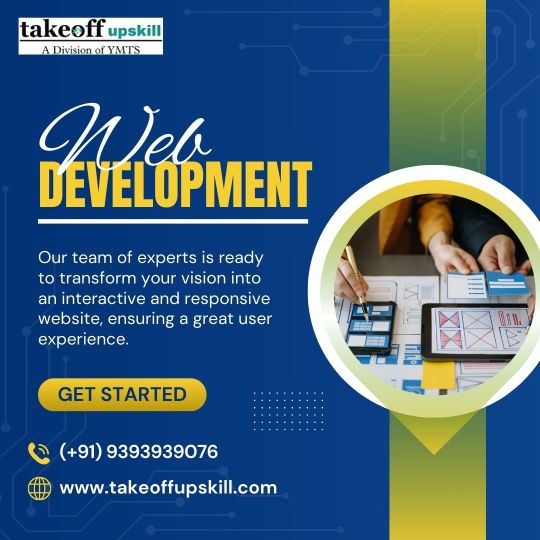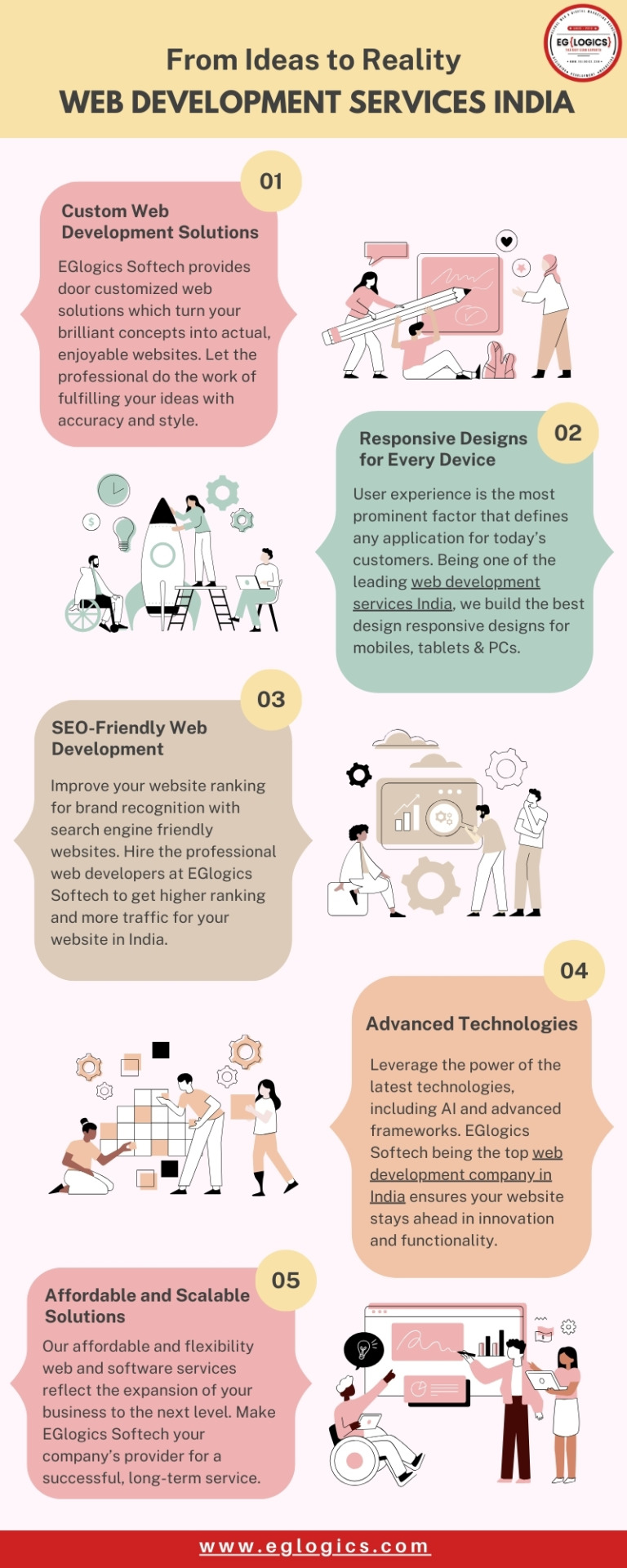#Web development course
Explore tagged Tumblr posts
Text
https://animatrix.in/
#Programming Course#Digital Marketing Course#Web Development Course#App Development Course#UI/UX Designing Course#2D & 3D Animation Course#Video editing#Graphic Design Course#Web Designing Course#Visual Effects (VFX) Course#Animatrix
2 notes
·
View notes
Text
What does a web development company do?
A web development company specializes in creating and maintaining websites for businesses and individuals. Their primary focus is on designing, building, and optimizing websites to meet the specific needs of their clients. This involves a range of tasks, including website layout design, content creation, coding, and testing to ensure functionality across different devices and browsers.
Web development companies also offer services such as e-commerce development, where they build online stores for businesses to sell products or services. They may integrate payment gateways, shopping carts, and inventory management systems to create seamless shopping experiences for customers.
Additionally, web development firms provide ongoing support and maintenance to ensure that websites remain secure, up-to-date, and optimized for performance. With their expertise in coding languages, design principles, and digital trends, web development agencies play a crucial role in helping businesses establish a strong online presence and achieve their digital objectives.
Truefirms have a vast list of web development companies with trusted client reviews and ratings. Explore Now
#web development#web development course#web development solutions#web development company#web development services#web development companies#web developers#website development
6 notes
·
View notes
Text
#web development course#web design company#top web development company#web development trends#web development 2024
2 notes
·
View notes
Text
Web Development Course in Tirupati
Web development career training is available through Takeoff Upskill where students can learn the best web development course in Tirupati. Takeoff Upskill provides students with the best Web Development Course in Tirupati. The training curriculum at Takeoff Upskill consists of HTML, CSS, JavaScript, React and additional components that aid in creating interactive websites. Professional trainer instruction together with practice assignments and certification enables students to develop necessary skills to obtain lucrative positions. People with any skill level should consider this course as their ideal choice. You should begin your web development path with Takeoff Upskill to build your career right now. Join now for early registration into the success building path.

You need to find the top web development training in Tirupati. Takeoff Upskill provides students every necessary skill from studying HTML through CSS to JavaScript and React and additional subjects. The educational design of our program supports those who are novice as well as those who seek advanced-level expertise for developing contemporary web applications. Expert trainers guide students through practical projects that deliver authentic skills in development or application building. Through our course students will find all the necessary tools to accomplish their dreams as either a front-end or full stack developer.
The learning environment at Takeoff Upskill delivers practical training, industry-relevant skills and certification for improving your employability prospects. Through our educational program students complete expert-moderated projects while they learn from professionals at flexible learning times. The best educational environment suits your learning preferences either through offline instruction or digital access. Companies are constantly searching for web developers with skills so the course authorizes students to select high paying positions in the IT sector.
Conclusion: Takeoff Upskill serves as the top destination to learn Web Development Course in Tirupati. Through our course students gain practical knowledge of HTML, CSS, JavaScript, React and additional subject matter for building actual-world programs. Expert training along with certification makes you ready for employment in just a short amount of time. The course structure has been created to teach beginners along with experienced learners alike. The moment to learn from experts comes only once. Takeoff Upskill represents the ideal choice for web development learning where you can build a successful web development career. Enroll immediately to achieve such career success.
0 notes
Text
Web Development Course in Chandigarh
https://www.excellencetechnology.in/web-designing-training-chandigarh/

1 note
·
View note
Text
#Web Development Course#Best Web Development Course#Web Development Course in Delhi#Best Web Development Course in Delhi#Web Development Course in Dwarka#Best Web Development Course in Dwarka#Web Development Course Online
0 notes
Text
Static vs Dynamic Websites: What Every Developer Needs to Know

When embarking on a journey in web development, it's essential to understand the fundamental differences between static and dynamic websites. As a developer, these two types of websites form the core of your skill set, and knowing their strengths and limitations will help you create better, more efficient websites. If you're looking to kickstart your journey, taking web development classes in Yamuna Vihar can give you the foundational knowledge needed to grasp these concepts thoroughly.
What Are Static Websites?
A static website is one where the content remains the same every time a user visits. These websites are often built using simple HTML and CSS, offering a straightforward way of presenting information. Static websites are ideal for small-scale projects like personal portfolios, blogs, or small business websites, where the content does not need to change frequently. Since static sites deliver the same content to all users, they are often faster and more secure compared to their dynamic counterparts.
One of the key advantages of static websites is their simplicity. They are easy to build, and the server doesn't need to do much processing, resulting in quicker load times. These websites are also less prone to security threats because they don’t rely on databases or server-side scripting languages. For businesses or individuals looking for a basic online presence, static websites can be an excellent and cost-effective solution.
However, static websites have limitations. Because the content is fixed, any change or update requires manual intervention by the developer. This makes static sites less suitable for websites that require frequent content changes or user interaction, such as e-commerce platforms or social networks.
What Are Dynamic Websites?
In contrast, dynamic websites are built using more complex technologies that allow content to change based on user interaction or other variables. These websites typically rely on server-side languages such as PHP, Python, or JavaScript frameworks like Node.js. They also often use databases to store and retrieve content, making them ideal for websites that need to present unique information to each visitor, like user profiles, blogs, or e-commerce sites.
Dynamic websites offer a much higher degree of flexibility and scalability than static websites. They allow for real-time content updates, user-generated data, and advanced features like search functions, interactive forms, and content management systems (CMS). These websites are essential for businesses that need to manage large volumes of content or offer personalized experiences for their users.
The trade-off, however, is that dynamic websites are generally more complex to develop and maintain. They require a server capable of processing scripts, accessing databases, and delivering dynamic content to the user. While the flexibility and interactivity they provide are significant advantages, they also come with the added responsibility of ensuring smooth server-side processing, security, and regular updates.
Key Differences Between Static and Dynamic Websites
Content Updates: Static websites require manual updates to change content, whereas dynamic websites automatically update content based on user interaction or data changes.
Technology Stack: Static sites rely on HTML, CSS, and simple JavaScript, while dynamic sites require server-side scripting languages, databases, and more advanced technologies.
Interactivity: Static websites offer minimal interaction, mainly focused on presentation. Dynamic websites, on the other hand, offer extensive interactivity through user input, databases, and real-time data.
Performance and Scalability: Static websites generally perform better and are faster because they don’t require server-side processing. Dynamic websites, due to their reliance on databases and server-side scripts, may experience slower load times, especially as they scale.
Cost: Static websites are generally less expensive to develop and host, while dynamic websites, due to their complexity and reliance on databases, can be costlier in both development and maintenance.
Which One Should You Choose?
The decision between a static or dynamic website largely depends on the specific needs of the project you're working on. If you are creating a website for a small business, personal portfolio, or informational page, a static site is an excellent option. It's quick to develop, easier to maintain, and cost-effective.
However, if you're working on a larger project that requires user interaction, real-time updates, or a content management system, a dynamic website is the better choice. For instance, e-commerce websites, social media platforms, and interactive web applications are typically dynamic websites.
For those looking to advance their careers as web developers, it’s crucial to have a solid understanding of both types of websites. Gaining this knowledge will not only make you a more versatile developer but will also open doors to more advanced projects. Enrolling in web development coaching institutes in Uttam Nagar can offer you hands-on experience and in-depth knowledge of both static and dynamic web technologies, preparing you for a successful career in this ever-evolving field.
Conclusion
Whether you're just starting or looking to enhance your web development skills, understanding the difference between static and dynamic websites is crucial. Static websites are simple, fast, and secure but are limited in terms of interactivity and content management. Dynamic websites, while more complex, offer greater flexibility, scalability, and interactivity, making them suitable for more advanced projects. By mastering both types of websites, you’ll be well-equipped to take on a variety of web development projects, from basic informational sites to complex, interactive web applications. For those looking to expand their skills further, joining a web development coaching institute in Uttam Nagar can provide the resources and expertise necessary to excel in the industry.
By considering the specific needs of your project and the trade-offs of each approach, you’ll be able to make an informed decision and create a website that not only meets but exceeds expectations.
Suggested Links
Web development course
Web Development Training
web development classes
#web development course#web developers#web design trends#web development technologies#web Development training institute#web Development course in Yamuna Vihar#web Development Tips#web development skills
0 notes
Text
A Web Development Institute helps you learn web design & coding skills. certifications show your knowledge while live projects give practical experience. together they build your portfolio proving your abilities to employers. choose an institute offering both to gain the skills & confidence needed for a successful web development career.
More Info : https://medium.com/@careerbossinstitute/why-certification-and-working-on-live-projects-are-essential-for-a-career-in-web-development-276ffad90884
0 notes
Text
Web Development Course by Takeoffupskill
Takeoffupskill offers a dynamic Web Development Course designed to equip you with the skills needed to thrive in the digital era. Whether you're a beginner eager to learn the fundamentals or a professional looking to advance your expertise, our course is tailored to meet your goals.

Our curriculum covers everything from the basics of web design to advanced web development techniques. You'll gain hands-on experience with essential technologies such as HTML, CSS, JavaScript, and frameworks like React and Angular. Additionally, you'll learn server-side programming with Node.js, database management with MongoDB, and deployment strategies to bring your projects to life.
Why Choose Takeoffupskill?
Expert-Led Training: Learn from seasoned professionals with real-world experience.
Practical Projects: Work on industry-relevant projects to build a strong portfolio.
Flexible Learning Options: Access online and offline classes to suit your schedule.
Comprehensive Support: Benefit from mentorship, doubt-clearing sessions, and career guidance.
Job Readiness: Prepare for the job market with resume building, interview prep, and placement assistance.
Our Web Development Course is more than just a learning program; it’s a pathway to a rewarding career. With a focus on practical skills and up-to-date industry trends, we ensure that you’re ready to tackle real-world challenges.
Takeoffupskill is committed to helping you achieve your professional aspirations. Enroll today and start your journey toward becoming a skilled web developer!
#Web Development Course#Learn Web Development#Web Development Training#Front-End Development Course#Back-End Development Course#Online Web Development Classes#Offline Web Development Course
0 notes
Text
From Ideas to Reality: Web Development Services India

Don’t let your dream of setting the perfect online presence stay as a dream, accomplish it with EGlogics Softech, a renowned web development company in India. As one of the best web development services India, we bring in unique web designs that are customized, responsive and compliant to best SEO practices. Grow up with our solutions provided by professionals! For more information visit https://www.eglogics.com/web-development-company-india/
0 notes
Text

Boost Your Career with the Best Digital Marketing & Web Development Course
"Take your career to new heights with Monavitech Education! 🚀 Enroll in our Full Stack Digital Marketing and Web Development Course and gain expertise in SEO, SMM, PPC, Email Marketing, Website Optimization, and much more. 🌟
💯 100% Placement Assistance 💰 Money-Back Guarantee Start your journey to success today! 📈 Your future in Digital Marketing and Web Development starts here!
For more details visit: https://monavitech.my.canva.site/
#Best Digital marketing course#Digital marketing course#Digital marketing course online#Best Digital marketing course near me#Social media marketing course#Seo course#Best Seo course#Web Development course#Best Web Development course near me
0 notes
Text
Web Development Course Barrackpore
Join PFSkillBuilders' web development course in Barrackpore. Learn HTML, CSS, JavaScript, and advanced frameworks with hands-on training and certifications.
0 notes
Text
A Step-by-Step Guide to Website Development Courses
Looking to master web development? Skillwalla’s guide to website development courses is perfect for beginners and professionals alike. Learn essential skills like HTML, CSS, JavaScript, backend programming, and more through structured lessons and real-world projects. With hands-on training and expert guidance, you’ll build a strong foundation and create a professional portfolio to kickstart your career. Join Skillwalla today and turn your web development dreams into reality!
0 notes
Text
Mastering full-stack development with Angular and Spring Boot equips developers with a powerful skill set to build robust, scalable, and efficient web applications. Angular, with its comprehensive front-end capabilities, offers dynamic and responsive user interfaces, while Spring Boot provides a reliable and flexible backend framework for handling data, security, and complex business logic.
0 notes
Text

Exploring the Path to Web Development: 7 Convincing Reasons to Dive In
https://incrediblelearningzone.blogspot.com/2025/01/7reasonstodowebdevelopmentcourse.html
#Web Development Course#Best Web Development Course#Web Development Course in Delhi#Best Web Development Course in Delhi#Web Development Course in Dwarka#Best Web Development Course in Dwarka#Web Development Course Online
0 notes
Text
Top 5 In-Demand Computer Science Skills You Need to Build a Successful Career

The field of computer science offers vast opportunities, but success in this ever-evolving industry requires more than just a basic understanding of programming. The demand for skilled professionals is at an all-time high, and employers are constantly looking for individuals who possess the right technical expertise and problem-solving abilities. Whether you're a student just starting your journey or someone looking to enhance your career, mastering the right set of skills is key. In this blog, we'll break down the top 5 in-demand computer science skills that can help you build a successful career.
1. Programming Languages
At the core of computer science lies programming. The ability to write clean, efficient, and bug-free code is crucial for any tech-related role. Familiarity with programming languages such as Java, Python, C++, JavaScript, and Ruby is highly valued by employers across industries.
Each language has its own unique applications, and mastering multiple languages can help open doors to various career paths. For instance, Python is ideal for data science and AI, while JavaScript is essential for web development. For students looking to gain proficiency, enrolling in Computer Science Classes in Yamuna Vihar can provide you with a solid foundation in these languages.
Having a firm grasp on multiple programming languages will help you solve complex problems efficiently, making you an attractive candidate for tech positions. Whether you're interested in software development, web development, or even game development, the ability to program is a must-have skill.
2. Data Structures and Algorithms
Data structures and algorithms form the backbone of efficient coding. Data structures are ways of organizing and storing data to ensure it can be accessed and modified efficiently, while algorithms are step-by-step instructions used to solve problems. Together, they help developers optimize their code, making it run faster and use fewer resources.
Knowledge of basic data structures like arrays, linked lists, stacks, and queues as well as more complex ones like hash tables and binary trees is essential for tackling problems in fields like software development and data science. Additionally, understanding algorithms such as sorting, searching, and dynamic programming can help solve some of the most complex computational problems in the industry.
3. Machine Learning and Artificial Intelligence (AI)
With technology advancing at an unprecedented rate, Artificial Intelligence (AI) and Machine Learning (ML) have become two of the most in-demand skills in the computer science industry. AI focuses on building machines that can simulate human intelligence, while ML teaches computers to learn from data and improve over time without being explicitly programmed.
As industries such as healthcare, finance, and retail adopt AI and ML to enhance their operations, professionals with expertise in these fields are increasingly sought after. Whether it's creating self-driving cars, improving medical diagnosis systems, or automating customer support, the applications of AI and ML are vast and growing.
4. Cybersecurity
As businesses and individuals continue to store more information online, the demand for cybersecurity professionals has skyrocketed. Cybersecurity is all about protecting systems, networks, and data from cyber threats and attacks. Professionals in this field help organizations safeguard their sensitive data and prevent security breaches that could compromise privacy or result in financial loss.
In today’s digital landscape, the need for cybersecurity experts has never been greater. As more industries move to the cloud and store vast amounts of data online, the risk of cyberattacks increases. Students interested in this field should focus on understanding network security, encryption techniques, and ethical hacking.
5. Cloud Computing
The rise of cloud computing has revolutionized the way businesses store, manage, and process data. Cloud services like Amazon Web Services (AWS), Microsoft Azure, and Google Cloud Platform allow companies to host applications, store data, and run processes remotely, providing flexibility and scalability.
Cloud computing professionals are in high demand because organizations increasingly rely on cloud infrastructure to meet their data storage and computing needs. Knowledge of cloud platforms, virtualization, and cloud security can open doors to a variety of roles, including cloud engineer, cloud architect, and cloud consultant.
Conclusion
The computer science industry offers a wide range of career opportunities, and with the right skills, you can build a rewarding and successful career. From mastering programming languages to diving into the world of AI and cloud computing, each skill set is a stepping stone toward success.
For students looking to enhance their expertise Computer Science Training Institute in Uttam Nagar offer great resources to build the foundational knowledge and hands-on experience needed for these in-demand skills. With the right training, you’ll be well-equipped to meet the growing demands of the computer science industry and carve out a fulfilling career.
By focusing on the right combination of technical skills, you'll ensure that you're not only prepared for today’s challenges but also ready to take on future opportunities in this dynamic field.
Suggested Links
Computer Science Training in Uttam Nagar
Computer Science Coaching Centre in Yamuna Vihar
Computer Science Course in Uttam Nagar
#computer science#Computer Science Training#Computer Scinece Training Institute#Computer Science Training Institute In Yamuna Vihar#Skills#skills development#Skils development Course#web development#Web Development Course
1 note
·
View note